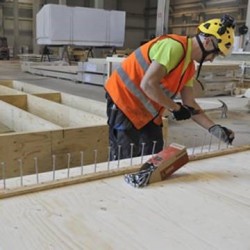With the amount of people in need of housing rising at a rate of 90,000 per day, modular design with prefabricated wood elements can offer a fast and efficient approach to building design.
McGraw Hill Construction recently conducted a study of companies that have utilised lean construction methods in their operations. Out of those surveyed, 84% reported higher quality in construction, and 80% experienced better customer satisfaction.
By employing prefabricated methods of construction, design firms can benefit from shorter design times; modular design enables each individual designer to handle more projects per year.
Modular design with engineered wood
Whilst a project may have to be executed quickly due to time constraints or limited work space, architects must be wary of quality when accelerating the speed of design. Hurrying may lead to design mistakes, which can cause further delays at the building site.
By utilising engineered wood products, such as Metsä Wood’s Kerto LVL (Laminated Veneer Lumber), designers can accelerate the design process, whilst maintaining a high level of quality.
Kerto’s technical and constructive qualities enable formal cuttings; the system offers more dimensional accuracy than other materials, such as steel or concrete, in which temperature needs to be considered.
Information about the environmental performance of Kerto products can be found in Metsä Wood’s Environmental Product Declaration.
Tools and technologies for modular design
When designing with wood, designers can employ a number of tools and technologies to enhance the process. Building Information Modelling (BIM) and calculation software, such as Finnframe and Finnwood, can support structural design and enhance resource efficiency.
Utilising prefabrication in design can enable interaction between the client, builder and design agencies; the use of predesigned elements speeds up the design process and eliminates mistakes.
Original link - Building Talk









